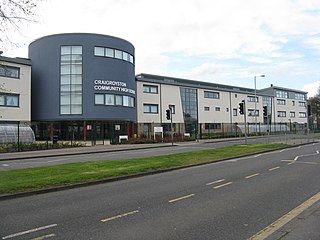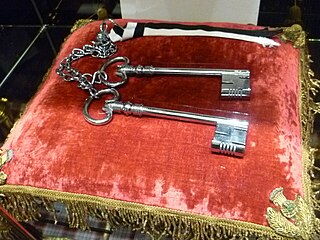The politics of Edinburgh are expressed in the deliberations and decisions of the City of Edinburgh Council, in elections to the council, the Scottish Parliament and the UK Parliament.

Leith is a port area in the north of Edinburgh, Scotland, founded at the mouth of the Water of Leith.

Queensferry, also called South Queensferry or simply "The Ferry", is a town to the west of Edinburgh, Scotland. Traditionally a royal burgh of West Lothian, it is now administered by the City of Edinburgh Council. It lies ten miles to the north-west of Edinburgh city centre, on the shore of the Firth of Forth between the Forth Bridge, Forth Road Bridge and the Queensferry Crossing. The prefix South serves to distinguish it from North Queensferry, on the opposite shore of the Forth. Both towns derive their name from the ferry service established by Queen Margaret in the 11th century, which continued to operate at the town until 1964, when the Road Bridge was opened.

A burgh is an autonomous municipal corporation in Scotland, usually a city, town, or toun in Scots. This type of administrative division existed from the 12th century, when King David I created the first royal burghs. Burgh status was broadly analogous to borough status, found in the rest of the United Kingdom. Following local government reorganisation in 1975, the title of "royal burgh" remains in use in many towns, but now has little more than ceremonial value.

Portobello is a coastal suburb of Edinburgh in eastern central Scotland. It lies 3 miles (5 km) east of the city centre, facing the Firth of Forth, between the suburbs of Joppa and Craigentinny. Although historically it was a town in its own right, it is officially a residential suburb of Edinburgh. The promenade fronts onto a wide sandy beach.
The High Constables of Holyroodhouse are a small corps of ceremonial bodyguards at the Sovereign's official residence in the Scottish capital, Edinburgh. Created in the early sixteenth century to protect the Monarch in residence at Holyrood, as well as to guard the Palace and Abbey, and enforce law and order within the precincts of the Palace and the Holyrood Abbey Sanctuary.

This article is a timeline of the history of Edinburgh, Scotland, up to the present day. It traces its rise from an early hill fort and later royal residence to the bustling city and capital of Scotland that it is today.
A bailie or baillie is a civic officer in the local government of Scotland. The position arose in the burghs, where bailies formerly held a post similar to that of an alderman or magistrate. Baillies appointed the high constables in Edinburgh, Leith and Perth. Modern bailies exist in Scottish local councils, with the position being a courtesy title and appointees often requested to provide support to the lord provost or provost - the ceremonial and civic head of the council - in their various engagements.

Lauriston Castle is a 16th-century tower house with 19th-century extensions overlooking the Firth of Forth, in Edinburgh, Scotland. It lies on Cramond Road South, between Cramond, Davidson's Mains, and Silverknowes. The substantial grounds, Lauriston Castle Gardens, operate as a local park. The castle was bequeathed to the Edinburgh Corporation and hosts the Lord Provost's annual Garden Party. The house is a Category A listed building and the grounds are included in the Inventory of Gardens and Designed Landscapes in Scotland.
George Darlington Wilson Grubb was a Scottish politician who served as the Lord Provost and ex officio Lord-Lieutenant of Edinburgh from May 2007 until May 2012. He was also a Liberal Democrat councillor of the City of Edinburgh Council for Almond ward. In 2012 he stood down as a councillor, at the end of his five-year term as Lord Provost.

The City of Edinburgh Council is the local government authority covering the City of Edinburgh council area. Almost half of the council area is the area of Edinburgh, capital of Scotland. With a population of 526,470 in mid-2019, it is the second most populous local authority area in Scotland.

Craigroyston Community High School is a non-denominational community secondary school in Muirhouse, Edinburgh.
Events from the year 1828 in Scotland.

The Incorporated Trades of Edinburgh are the trade and craft bodies of the City of Edinburgh, Scotland, in much the same way as the Livery companies are in The City of London, but on a much smaller scale. The Incorporations are not "guilds", that term being properly reserved in Scotland for the merchant bodies in the various burghs. The Incorporations have never referred to themselves as guilds; indeed they came into existence, mostly in the latter part of the fifteenth century, in order to counter the growing power of the merchant guild, known as the Royal Company of Merchants of the City of Edinburgh.

The High Constables of Edinburgh are a prestigious body of constables, founded in 1611 and located in Edinburgh, Scotland. Historically, the High Constables were charged with policing the streets of Edinburgh, the capital city of Scotland, however today their duties are mostly ceremonial. It is believed that the High Constables of Edinburgh are the first example of a statutory police force in the world. At one time they formed part of the now defunct Corporation of the City of Edinburgh and continue to serve a ceremonial function in the local government of Edinburgh.

The Ceremony of the Keys is held in Holyrood Palace, Edinburgh, at the start of the British monarch's week-long residence there in July. Soon after the monarch's arrival, in the forecourt of the Palace, the King or Queen is symbolically offered the keys to the city of Edinburgh by the Lord Provost:
We, the Lord Provost and the members of the City of Edinburgh Council, welcome Your Majesty to the capital city of your Ancient and Hereditary Kingdom of Scotland and offer for your gracious acceptance the Keys of Your Majesty's good City of Edinburgh.

The following outline is provided as an overview of and topical guide to Edinburgh:
Sir John Smith of Grothill and Kings Cramond was a 17th-century Scottish landowner and merchant who served as Lord Provost of Edinburgh from 1643 to 1646.
John William Chesser SSC was a 19th/20th century Scottish solicitor and Tory politician who served as Lord Provost of Edinburgh from 1919 to 1921.
Walter Brown (c.1770–c.1840) was a Scottish wine merchant who served as Lord Provost of Edinburgh from 1827 to 1829.















